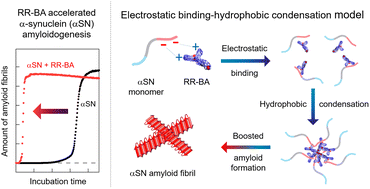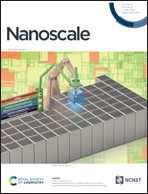An amphiphilic material arginine–arginine–bile acid promotes α-synuclein amyloid formation†
Abstract
Amyloid generation plays essential roles in various human diseases, biological functions, and nanotechnology. However, developing efficient chemical and biological candidates for regulating amyloid fibrillation remains difficult because information on the molecular actions of modulators is insufficient. Thus, studies are needed to understand how the intermolecular physicochemical properties of the synthesised molecules and amyloid precursors influence amyloidogenesis. In this study, we synthesised a novel amphiphilic sub-nanosized material, arginine–arginine (RR)–bile acid (BA), by conjugating positively charged RR to hydrophobic BA. The effects of RR–BA on amyloid formation were investigated on α-synuclein (αSN) in Parkinson's disease and on K18 and amyloid-β (1–42) (Aβ42) in Alzheimer's disease. RR–BA showed no appreciable effect on the kinetics of K18 and Aβ42 amyloid fibrillation because of their weak and non-specific interactions. However, RR–BA specifically bound to αSN with moderate binding affinity through electrostatic interactions between the positively charged RR and the negatively charged cluster in the C-terminus of αSN. In addition, hydrophobic BA in the αSN–RR–BA complex transiently condensed αSN for primary nucleation, thereby accelerating αSN amyloid fibrillation. We propose an electrostatic binding and hydrophobic condensation model of RR–BA-driven amyloid formation of αSN, which will contribute to the rational design and development of molecules for controlling amyloid aggregation in diverse fields.

- This article is part of the themed collection: Design and function of materials nanoarchitectonics


 Please wait while we load your content...
Please wait while we load your content...